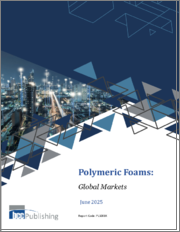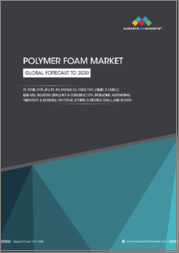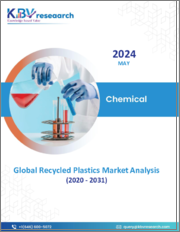
|
시장보고서
상품코드
1441994
폴리머 폼 시장 : 제품 유형별, 폼 유형별, 용도별, 예측(2023-2032년)Polymeric Foams Market - By Product (Polyurethane (PU) Foam, Polystyrene (PS) Foam, Polyethylene (PE) Foam, Polyvinyl Chloride (PVC) Foam), By Foam type (Rigid, Flexible), By Applications & Forecast, 2023 - 2032 |
||||||
폴리머 폼 세계 시장 규모는 2024년부터 2032년까지 연평균 4.3% 성장할 것으로 예상됩니다.
환경에 대한 관심이 높아지면서 산업계는 환경 친화적인 폼 솔루션을 찾고 있습니다. 또한, 혁신적인 생산 기술 및 소재 등 제조 공정의 발전도 시장 확대에 기여하고 있습니다. 또한, 지속가능성에 대한 관심에 부응하고 향상된 성능 특성을 제공하는 신제품 출시가 시장 성장을 촉진하고 있습니다. 산업계가 친환경 소재와 효율성을 우선시하는 가운데, 폴리머 폼 산업은 향후 몇 년 동안 큰 폭의 성장을 기록할 것으로 예상됩니다.
예를 들어, 2024년 1월, Neveon은 매트리스용으로 설계된 더 가볍고 지속가능한 폴리우레탄(PU) 폼인 Foam hybrid Endura를 발표했습니다. 재생 가능한 원료를 30% 함유한 이 혁신적인 폼은 품질과 성능을 유지하면서 지속가능성을 높인 제품입니다. 이번 출시는 폴리우레탄 폼의 지속가능성과 성능 강화를 위한 중요한 발걸음이며, 이를 통해 시장에서의 매력도를 높이고 다양한 용도의 다목적 친환경 소재로서의 입지를 강화할 수 있을 것으로 기대됩니다.
폴리머 폼 시장은 유지보수 제품, 용도 및 지역별로 분류됩니다.
폴리스티렌(PS) 폼 분야는 경량성, 우수한 단열 특성 및 비용 효율성으로 인해 포장, 건축 및 단열 용도에 PS 폼이 널리 사용됨에 따라 2032년까지 큰 이익을 얻을 것으로 예상됩니다. 또한, 자동차 산업에서 PS 폼의 소음 및 진동 감쇠에 대한 수요가 증가함에 따라 PS 폼의 시장 우위가 더욱 강화될 것으로 보입니다. 다양한 용도와 우수한 특성으로 인해 PS 폼은 폴리머 폼 산업에서 선도적인 위치를 유지할 것으로 보입니다.
패키징 분야는 식음료, 전자제품, 의약품 등 다양한 산업에서 폴리머 폼이 광범위하게 사용되고 있는 것에 힘입어 2032년까지 큰 폭의 성장을 보일 것으로 예상됩니다. 가볍고 보호력이 뛰어나며 다재다능한 패키징 솔루션에 대한 수요가 증가함에 따라 폴리머 폼은 계속해서 선호되는 선택이 되고 있습니다. 산업계가 제품 안전과 운송 효율을 우선시하는 가운데, 포장 분야는 앞으로도 시장 성장의 주요 촉진제가 될 것으로 보입니다.
아시아태평양의 폴리머 폼 시장은 2024년부터 2032년까지 연평균 성장률(CAGR)이 두드러질 것으로 예상됩니다. 또한, 급속한 도시화와 인프라 개발은 건설, 자동차 및 포장 산업에서 폴리머 폼에 대한 수요를 촉진하고 있습니다. 아시아태평양은 지속적인 경제 성장과 산업 확장으로 전체 폴리머 폼 시장의 규모와 역학에 큰 기여를 할 것으로 예상됩니다.
목차
제1장 조사 방법과 조사 범위
제2장 주요 요약
제3장 폴리머 폼 산업 인사이트
- 생태계 분석
- 원재료 공급업체
- 제조업체
- 이익률 분석
- 유통 채널 분석
- 최종사용자
- 벤더 매트릭스
- 주요 원재료 공급업체 리스트
- 주요 제조업체/공급업체 리스트
- 주요/잠재 고객 리스트
- 기술 상황
- 규제 상황
- 업계에 대한 영향요인
- 성장 촉진요인
- 업계의 잠재적 리스크와 과제
- 가격 분석
- 지역별 가격 설정
- 비용 구조 분석
- 연구개발 비용
- 제조·설비 비용
- 원재료비
- 유통 비용
- 영업 비용
- 잡비
- 혁신과 지속가능성
- 특허 분석
- 성장성 분석
- Porters 분석
- PESTEL 분석
제4장 경쟁 상황
- 소개
- 기업 점유율
- 지역별 점유율
- 시장 경쟁 분석
- 경쟁 포지셔닝 매트릭스
- 전략 전망 매트릭스
제5장 폴리머 폼 시장 규모와 예측 : 제품별 2018-2032년
- 폴리우레탄(PU) 폼
- 폴리스티렌(PS) 폼
- 폴리에틸렌(PE) 폼
- 폴리염화비닐(PVC) 폼
- 기타
제6장 폴리머 폼 시장 규모와 예측 : 폼 유형별 2018-2032년
- 경질
- 연질
제7장 폴리머 폼 시장 규모와 예측 : 용도별 2018-2032년
- 자동차
- 건축·건설
- 포장
- 가구
- 가전
- 기타
제8장 고분자 발포체 시장 규모와 예측 : 지역별 2018-2032년
- 주요 동향 : 지역별
- 북미
- 미국
- 캐나다
- 유럽
- 독일
- 영국
- 프랑스
- 스페인
- 이탈리아
- 러시아
- 아시아태평양
- 일본
- 중국
- 인도
- 호주
- 한국
- 인도네시아
- 말레이시아
- 라틴아메리카
- 브라질
- 멕시코
- 아르헨티나
- 중동 및 아프리카
- 남아프리카공화국
- 사우디아라비아
- 아랍에미리트
제9장 기업 개요
- Dow Chemical
- BASF SE
- Covestro
- Huntsman Corporation
- Evonik Industries
- LyondellBasell
- LG Chem
- Asahi Kasei
- SABIC
- JXTG Nippon Oil & Energy
- Sumitomo Chemical
- Toray Industries
- Mitsubishi Chemical Corporation
- China Petrochemical Corporation(Sinopec)
- China National Chemical Corporation(ChemChina)
Global Polymeric Foams Market size will grow at a 4.3% CAGR from 2024 to 2032, driven by a growing emphasis on sustainability and recyclability. With increasing environmental concerns, industries are seeking eco-friendly foam solutions. Additionally, advancements in manufacturing processes, such as innovative production techniques and materials, contribute to market expansion. Furthermore, new product launches addressing sustainability concerns and offering enhanced performance characteristics propel market growth. As industries prioritize eco-friendly materials and efficiency, the polymeric foams industry will register significant expansion in the coming years.
For instance, in January 2024, Neveon introduced Foam hybrid Endura, a lighter and more sustainable polyurethane (PU) foam designed for mattresses. This innovative foam, made with 30% renewable raw materials, offers enhanced sustainability while maintaining quality and performance. This launch signifies a significant step towards enhancing the sustainability and performance of polymeric foams, thereby expanding their appeal in the market and reinforcing their position as versatile and eco-friendly materials in various applications.
The polymeric foams market is classified based on maintenance product, application, and region.
The polystyrene (PS) foam segment will garner significant gains by 2032, fueled by PS foam's widespread use in packaging, construction, and insulation applications due to its lightweight nature, excellent thermal insulation properties, and cost-effectiveness. In addition, the growing demand for PS foam in the automotive industry for noise and vibration damping will further contribute to its market dominance. With its versatile applications and favorable properties, the PS foam segment will maintain a leading position in the polymeric foams industry.
The packaging segment will witness a substantial upswing by 2032, propelled by the extensive use of polymeric foams in various packaging applications across industries such as food and beverage, electronics, and pharmaceuticals. With the growing demand for lightweight, protective, and versatile packaging solutions, polymeric foams continue to be the preferred choice. As industries prioritize product safety and transportation efficiency, the packaging segment will remain a key driver of market growth.
Asia Pacific polymeric foams market will register a remarkable CAGR from 2024 to 2032, owing to the burgeoning manufacturing sector in the region, particularly in countries such as China and India. Additionally, rapid urbanization and infrastructure development fuel the demand for polymeric foams in the construction, automotive, and packaging industries. As Asia Pacific continues to witness economic growth and industrial expansion, it will emerge as a significant contributor to the polymeric foams market's overall size and dynamics.
Table of Contents
Chapter 1 Methodology & Scope
- 1.1 Market scope & definitions
- 1.2 Base estimations & working
- 1.3 Forecast calculation
- 1.4 Data sources
- 1.4.1 Primary
- 1.4.2 Data mining sources
- 1.4.2.1 Paid sources
- 1.4.2.2 Public sources
Chapter 2 Executive Summary
- 2.1 Polymeric foams industry 360 degree synopsis, 2018 - 2032
- 2.2 Business trends
- 2.3 Product trends
- 2.4 Foam type trends
- 2.5 Application trends
- 2.6 Regional trends
Chapter 3 PolymericFoams Industry Insights
- 3.1 Industry ecosystem analysis
- 3.1.1 Raw material suppliers
- 3.1.2 Manufacturers
- 3.1.3 Profit margin analysis
- 3.1.4 Distribution channel analysis
- 3.1.5 End-users
- 3.1.6 Vendor matrix
- 3.1.6.1 List of key raw material suppliers
- 3.1.6.2 List of key manufacturers/suppliers
- 3.1.6.3 Lits of key/potential customers
- 3.2 Technology landscape
- 3.3 Regulatory landscape
- 3.3.1 North America
- 3.3.2 Europe
- 3.3.3 Asia Pacific
- 3.3.4 Latin America
- 3.3.5 Middle East & Africa
- 3.4 Industry impact forces
- 3.4.1 Growth drivers
- 3.4.2 Industry pitfalls & challenges
- 3.5 Pricing analysis
- 3.5.1 Regional pricing
- 3.5.1.1 North America
- 3.5.1.2 Europe
- 3.5.1.3 Asia Pacific
- 3.5.1.4 Latin America
- 3.5.1.5 Middle East & Africa
- 3.5.2 Cost structure analysis
- 3.5.2.1 R&D cost
- 3.5.2.2 Manufacturing & equipment cost
- 3.5.2.3 Raw material cost
- 3.5.2.4 Distribution cost
- 3.5.2.5 Operating cost
- 3.5.2.6 Miscellaneous cost
- 3.5.1 Regional pricing
- 3.6 Innovation & sustainability
- 3.6.1 Patent analysis
- 3.7 Growth potential analysis
- 3.8 Porter's analysis
- 3.9 PESTEL analysis
Chapter 4 Competitive Landscape, 2023
- 4.1 Introduction
- 4.2 Company market share, 2023
- 4.2.1 Company market share, by region, 2023
- 4.2.1.1 North America
- 4.2.1.2 Europe
- 4.2.1.3 Asia Pacific
- 4.2.1.4 Latin America
- 4.2.1.5 Middle East & Africa
- 4.2.1 Company market share, by region, 2023
- 4.3 Competitive analysis of market player
- 4.4 Competitive positioning matrix
- 4.5 Strategic outlook matrix
Chapter 5 PolymericFoams Market Size And Forecast, By Product 2018 - 2032(Tons, USD Billion)
- 5.1 Polyurethane (PU) foam
- 5.2 Polystyrene (PS) foam
- 5.3 Polyethylene (PE) foam
- 5.4 Polyvinyl chloride (PVC) foam
- 5.5 Others
Chapter 6 PolymericFoams Market Size and Forecast, By Foam Type 2018 - 2032(Tons, USD Billion)
- 6.1 Rigid
- 6.2 Flexible
Chapter 7 PolymericFoams Market Size and Forecast, By Application 2018 - 2032 (Tons, USD Billion)
- 7.1 Automotive
- 7.2 Building & construction
- 7.3 Packaging
- 7.4 Furniture
- 7.5 Appliances
- 7.6 Others
Chapter 8 PolymericFoams Market Size and Forecast, By Region 2018 - 2032(Tons, USD Billion)
- 8.1 Key trends, by region
- 8.2 North America
- 8.2.1 U.S.
- 8.2.2 Canada
- 8.3 Europe
- 8.3.1 Germany
- 8.3.2 UK
- 8.3.3 France
- 8.3.4 Spain
- 8.3.5 Italy
- 8.3.6 Russia
- 8.4 Asia Pacific
- 8.4.1 Japan
- 8.4.2 China
- 8.4.3 India
- 8.4.4 Australia
- 8.4.5 South Korea
- 8.4.6 Indonesia
- 8.4.7 Malaysia
- 8.5 Latin America
- 8.5.1 Brazil
- 8.5.2 Mexico
- 8.5.3 Argentina
- 8.6 MEA
- 8.6.1 South Africa
- 8.6.2 Saudi Arabia
- 8.6.3 UAE
Chapter 9 Company Profiles
- 9.1 Dow Chemical
- 9.2 BASF SE
- 9.3 Covestro
- 9.4 Huntsman Corporation
- 9.5 Evonik Industries
- 9.6 LyondellBasell
- 9.7 LG Chem
- 9.8 Asahi Kasei
- 9.9 SABIC
- 9.10 JXTG Nippon Oil & Energy
- 9.11 Sumitomo Chemical
- 9.12 Toray Industries
- 9.13 Mitsubishi Chemical Corporation
- 9.14 China Petrochemical Corporation (Sinopec)
- 9.15 China National Chemical Corporation (ChemChina)



















